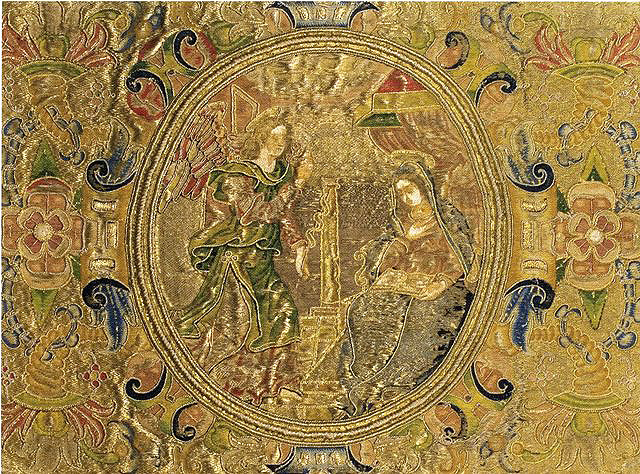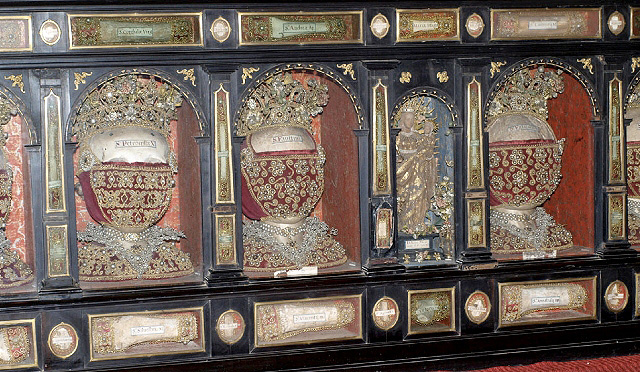The piece of the month of September 2010
OF ARTIST NUNS IN THE ENCLOSURES OF PAMPLONA IN THE 17TH CENTURY
Ricardo Fernández Gracia
Chair of Navarrese Heritage and Art
Among the secrets preserved in our female cloisters are all those religious hands that with patience and time elaborated so many and so many pieces that, in some cases, went outside the cloister, because of their quality, or simply as a gift for relatives and benefactors.
In final nuns artists and craftswomen. Among the former, a special place is occupied by Mother Graciosa de los Ángeles, a Discalced Carmelite nun from the convent of San José de Pamplona and author of the rich terno for the pontificals of the recently restored monastery of Fitero.
In the same way that the tracista friars turned their work into art, when designing buildings, some cloistered nuns reached such a level of Degree of specialization in their embroidery tasks that they emulated the professional embroiderers, then men. Such was the case of the Discalced Carmelite nun Graciosa de los Angeles (+1672), of the Carmel of San Jose de Pamplona. In an account of her life from the conventual file , her virtues are praised, among which her excellent hands for work stand out, with which she was of great use to the community, adding that "she embroidered with great care and whatever Mother Graciosa did, she left it finished with all perfection and in a terno in which the mothers earned a thousand ducats from the work alone, Mother Graciosa was one of those who took the greatest care and her fervor was such and that of the others who did this work, that the Father Provincial, Fray Martin de los Angeles, was one of the most careful, that the Provincial Father Fray Martin de Jesús Mª was forced to order in the visit and he left in writing among other things that the nuns should not get up at four o'clock to work and this suit was for the Royal House of Fitero and all this work he said to be done and it is due to the diligence of mother Ana Maria de Jesús, that great nun". Thus reads her death certificate preserved in the Book of the Deceased of the Carmel of Pamplona.
A re-reading of the conventual chronicles, in this case of the Augustinian Recollect Nuns, both the manuscripts and above all those published by Father Alonso de Villerino in the last third of the 17th century, gives us some clues about a couple of nuns whose activity went beyond the strict walls of the Pamplona cloister. Through the first and third volumes that with degree scroll of Esclarecido solar de las Religiosas Recoletas de Nuestro Padre San Agustín y vidas de las Insignes hijas de sus conventos, published in Madrid in 1690 and 1694, we can trace the abilities of a couple of nuns who lived in Pamplona in the 17th century.
The first of these is Mother Josefa de San Francisco, superior of the house between 1637 and 1665 and therefore one of the pillars of the community that had arrived in Pamplona in 1634. She tells us about her (Volume I, pp. 460-461): "She was so zealous for Divine Worship that in the midst of her serious ailments that she suffered and the occupations of her official document, sheworked for the adornment of the church, as if she had no ailments or official document to occupy her. Not only in his House he gave great luster to the cult of the Festivities, but that to his example all the convents of Pamplona increased him, that this way I have heard it to say it myself to many people of the time of the entrance of the Recollection in that city, which assured that before entering the Recollection, the altars were made with very temperate adornment and that later they are made with majestic apparatus in all the Communities, that came to seem excessive to the prudent ones and worthy of reform". It is therefore proven that, as in other aspects, the monasteries and convents were in the artistic vanguard in that century of the Baroque.
Later he adds (Volume I, page. 461): "The Venerable Mother San Francisco was the first one who taught to make flowers in her convent and likewise she taught her daughters to make the ternos and other things of the service of the sacristy and to cut the wardrobe that they wear and to sew it, since all this is done in the convent... These and other abilities of the Recollect Mothers of Pamplona, that by their exquisite effects have been let known with due applause with due and remote parts of the World, inherited of so prodigious Mother ....".

"Dalmática de Terno". Barefoot Carmelite nuns of San José de Pamplona, second quarter of the XVII century.
White tissue, gold, silver and colored silks. 1114 x cm
Fitero. Parish of Santa María la Real
Villerino refers to a second nun in volume III of his work, specifically to Mother Teresa de los Angeles. Maria Teresa de los Angeles entered the Augustinian Recollect Nuns of Pamplona in 1637 and was prioress for a long period, between 1665 and 1692. In the printed biography that Father Villerino left of the nun, he describes her as a true paragon of virtues, very fond of the cult of the divine and of the images of Christ and especially of the Virgin, whether they were from home or from outside. She also affirms that many gifts for the divine cult arrived thanks to her gifts and good work, among them sculptures and a Neapolitan frontal that arrived thanks to the offices of her brother Don José de Azpíroz, relative of the viceroy and later archbishop of Todelo, Cardinal Don Pascual de Aragón.
The aforementioned Villerino refers to her facet as a skillful nun in this way: "since she entered the sacristy, she invented such bouquets and flowers that she adorned the church and sacristy; and what is more, most of the relics with which the Founder, extraordinarily enriched that house, by her hands she adorned them so beautifully that they are a sweet delight to the eye. And if he shone his skill in this, he excelled even more in the sewing of clothes for the sacristy, because he had such a skill, that he sewed for two women....." (p. 569) and further on, he also had such a great talent for sewing that he sewed for two women . 569) and further on, as follows: "He took special care of the worship of the images of Our Lady, making sure that they were decent, not only in his convent, which is supposed to be the case, but throughout the land and in the most neglected places: he had given orders to persons of his satisfaction so that any image of that land that did not have decent adornment, should be taken to his convent, where many entered as Aldeanitas and came out as Princesses in dress.... She employed the devotion of her daughters in many headdresses, making by her hands the rostrillo of each one, and the last thing in which she occupied them was in making, in the middle of her exquisite pains with imponderable work a rostrillo for Our Lady of the convent of the Merced of the city of Tudela, 18 leagues from the city of Pamplona, that for knowing of her holy devotion was requested to her in the greatest predicament of her torments" (p. 580). 580).
In the cloister of the Recollects of Pamplona and specifically in its chapterhouse conference room there are numerous reliquaries with embroideries made by the aforementioned nuns, combining Flemish velvets with pearls and golden threads, highlighting the covers with which different skulls of other saints are covered.

Detail of the reliquary cupboard of the conference room Capitular of Recoletas with the reliquaries adorned with embroidery and pearls.
